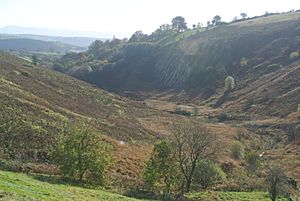Cefn Blaenau facts for kids
Cefn Blaenau is a special natural area in Carmarthenshire, Wales. It's about 23 hectares, which is like 23 football fields! In 1989, it became a Site of Special Scientific Interest (SSSI). This means it's protected because it has unique plants and habitats.
This area is important for its wet, boggy places where springs bubble up. It also has many different types of land. These include grassy fields, marshy areas, wet heathland, and woodlands. There are also streams and small rocky spots. These kinds of habitats are now rare in north Carmarthenshire. Many have been lost due to farming changes and planting too many trees. Cefn Blaenau helps protect these special places.
Contents
What Makes Cefn Blaenau Special?
Cefn Blaenau is a small valley with the start of the River Marlais. This river flows into the River Cothi. The valley floor has many wet, boggy areas. These areas slowly change into wet, grassy fields. These fields are full of purple moor-grass and different types of sedges.
Plants of the Wet Areas
In the very wet parts of the valley, you can find lots of bog-mosses. These are special mosses that hold a lot of water. Other interesting plants here include:
- marsh St John’s-wort
- round-leaved sundew, which is a plant that eats insects!
- common butterwort, another insect-eating plant
- bog pondweed
At the bottom of the valley slopes, there are more boggy spots. Here you might see:
- common cottongrass, which has fluffy white tops
- cross-leaved heath
- common bilberry, which produces tasty berries
- marsh lousewort
- many-stalked spike-rush
The wet, grassy fields are home to some plants that are not very common. These include:
- whorled caraway
- bog asphodel, a plant with bright yellow flowers
- heath spotted-orchid, a beautiful purple orchid
Plants Along the Streams
Along the sides of the streams, there are narrow areas of wet, fen-like plants. These include different types of rushes and many wildflowers. Some of these are:
- ragged-robin, with its pink, ragged petals
- marsh thistle
- greater bird's-foot-trefoil
- marsh bedstraw
- sneezewort
- marsh marigold, a bright yellow flower
- meadowsweet
- meadow vetchling
- devil's-bit scabious
- lady-fern
In more open spots near the streams, you can find even rarer plants. These include the ivy-leaved bellflower and bog pimpernel.
Plants of the Drier Slopes
The drier slopes of the valley have grassy areas. These are grazed by animals. Here you can find plants like:
- tormentil
- wavy hair-grass
- heath bedstraw
- pig nut
- different types of mosses
Some wet areas also run down these dry slopes. Where the soil is deeper, you'll see lots of bracken. There are also areas of grass and small bushes like willow and hawthorn.
Amazing Wildlife
Cefn Blaenau is a great place for many animals, especially birds and insects.
Birds of the Valley
The areas with bracken and bushes are important for nesting birds. You might spot:
Bigger birds of prey are also often seen flying over the valley. These include:
Butterflies and Dragonflies
Cefn Blaenau is home to many beautiful butterflies. Four types of fritillary butterflies have been seen here:
- marsh fritillary
- small pearl-bordered fritillary
- dark green fritillary
- silver-washed fritillary
The marsh and small pearl-bordered fritillaries like the wet, grassy areas. The dark green fritillary prefers the drier slopes with bracken. The silver-washed fritillary can be found in the tree tops. All these butterflies are becoming rare in the UK.
Other special butterflies here include the rare brown hairstreak. You can also find many small copper and green hairstreak butterflies.
The valley is also rich in dragonflies and damselflies. One special dragonfly found in the wet, spring-fed areas is the keeled skimmer. Its young live in the wet mud of these boggy pools.
Other dragonflies you might see are:
- emperor
- golden-ringed
- broad-bodied chaser
- four-spotted chaser
- southern hawker
- common hawker
- black-tailed skimmer
- common darter
- black darter
Damselflies include:
- large red
- azure
- emerald
- common blue
- blue-tailed
- scarce blue-tailed
- beautiful demoiselle
Other Animals
The area is also home to many mustelids, which are a family of mammals. These include:
You can also find brown hares living in the valley.
Visiting Cefn Blaenau
Cefn Blaenau is privately owned land. This means there is no public access. If you wish to visit, you need to ask the owners for permission first.


